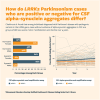LRRK2-associated parkinsonism with and without in vivo evidence of alpha-synuclein aggregates: longitudinal clinical and biomarker characterization
- PMID: 40114783
- PMCID: PMC11925012
- DOI: 10.1093/braincomms/fcaf103
LRRK2-associated parkinsonism with and without in vivo evidence of alpha-synuclein aggregates: longitudinal clinical and biomarker characterization
Abstract
Among LRRK2-associated parkinsonism cases with nigral degeneration, over two-thirds demonstrate evidence of pathologic alpha-synuclein, but many do not. Understanding the clinical phenotype and underlying biology in such individuals is critical for therapeutic development. Our objective was to compare clinical and biomarker features, and rate of progression over 4 years of follow-up, among LRRK2-associated parkinsonism cases with and without in vivo evidence of alpha-synuclein aggregates. Data were from the Parkinson's Progression Markers Initiative, a multicentre prospective cohort study. The sample included individuals diagnosed with Parkinson disease with pathogenic variants in LRRK2. Presence of CSF alpha-synuclein aggregation was assessed with seed amplification assay. A range of clinician- and patient-reported outcome assessments were administered. Biomarkers included dopamine transporter scan, CSF amyloid-beta1-42, total tau, phospho-tau181, urine bis(monoacylglycerol)phosphate levels and serum neurofilament light chain. Linear mixed-effects (LMMs) models examined differences in trajectory in CSF-negative and CSF-positive groups. A total of 148 LRRK2 parkinsonism cases (86% with G2019S variant), 46 negative and 102 positive for CSF alpha-synuclein seed amplification assay, were included. At baseline, the negative group was older than the positive group [median (inter-quartile range) 69.1 (65.2-72.3) versus 61.5 (55.6-66.9) years, P < 0.001] and a greater proportion were female [28 (61%) versus 43 (42%), P = 0.035]. Despite being older, the negative group had similar duration since diagnosis and similar motor rating scale [16 (11-23) versus 16 (10-22), P = 0.480] though lower levodopa equivalents. Only 13 (29%) of the negative group were hyposmic, compared with 75 (77%) of the positive group. The negative group, compared with the positive group, had higher per cent-expected putamenal dopamine transporter binding for their age and sex [0.36 (0.29-0.45) versus 0.26 (0.22-0.37), P < 0.001]. Serum neurofilament light chain was higher in the negative group compared with the positive group [17.10 (13.60-22.10) versus 10.50 (8.43-14.70) pg/mL; age-adjusted P-value = 0.013]. In terms of longitudinal change, the negative group remained stable in functional rating scale score in contrast to the positive group who had a significant increase (worsening) of 0.729 per year (P = 0.037), but no other differences in trajectory were found. Among individuals diagnosed with Parkinson disease with pathogenic variants in the LRRK2 gene, we found clinical and biomarker differences in cases without versus with in vivo evidence of CSF alpha-synuclein aggregates. LRRK2 parkinsonism cases without evidence of alpha-synuclein aggregates as a group exhibit less severe motor manifestations and decline. The underlying biology in LRRK2 parkinsonism cases without evidence of alpha-synuclein aggregates requires further investigation.
Keywords: LRRK2 gene; Parkinson’s disease; alpha-synuclein.
© The Author(s) 2025. Published by Oxford University Press on behalf of the Guarantors of Brain.
Conflict of interest statement
The authors report no competing interests.
Update of
-
LRRK2-Associated Parkinsonism With and Without In Vivo Evidence of Alpha-Synuclein Aggregates.medRxiv [Preprint]. 2024 Jul 22:2024.07.22.24310806. doi: 10.1101/2024.07.22.24310806. medRxiv. 2024. Update in: Brain Commun. 2025 Mar 06;7(2):fcaf103. doi: 10.1093/braincomms/fcaf103. PMID: 39108519 Free PMC article. Updated. Preprint.
References
LinkOut - more resources
Full Text Sources
Miscellaneous

